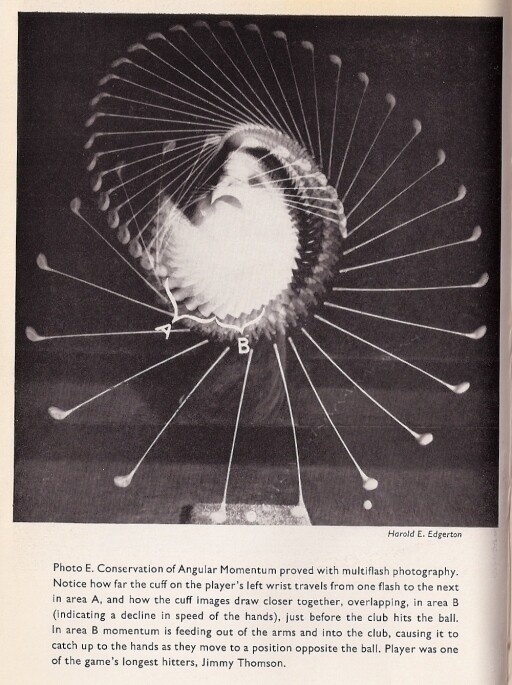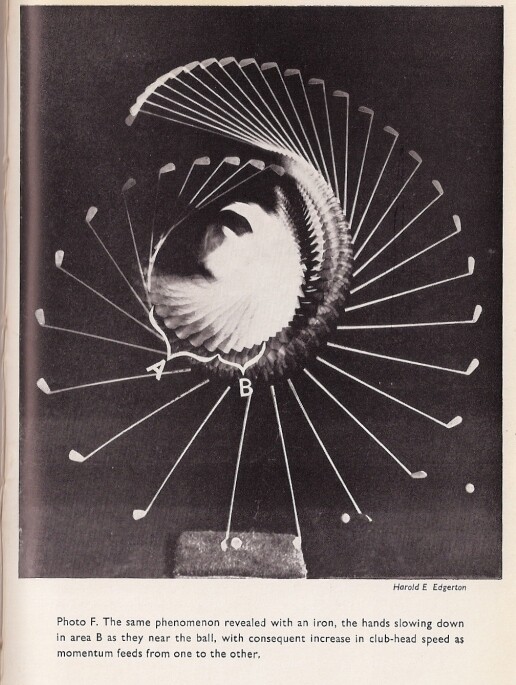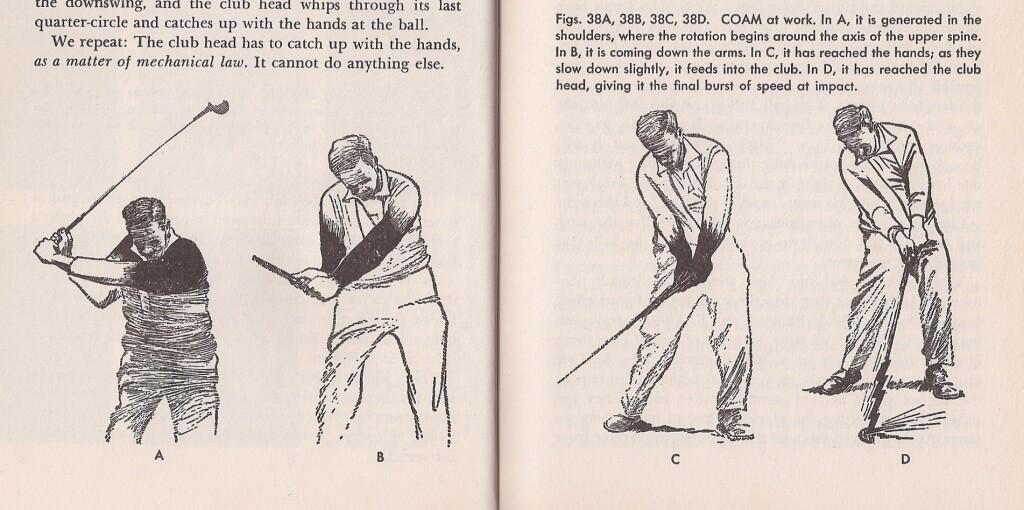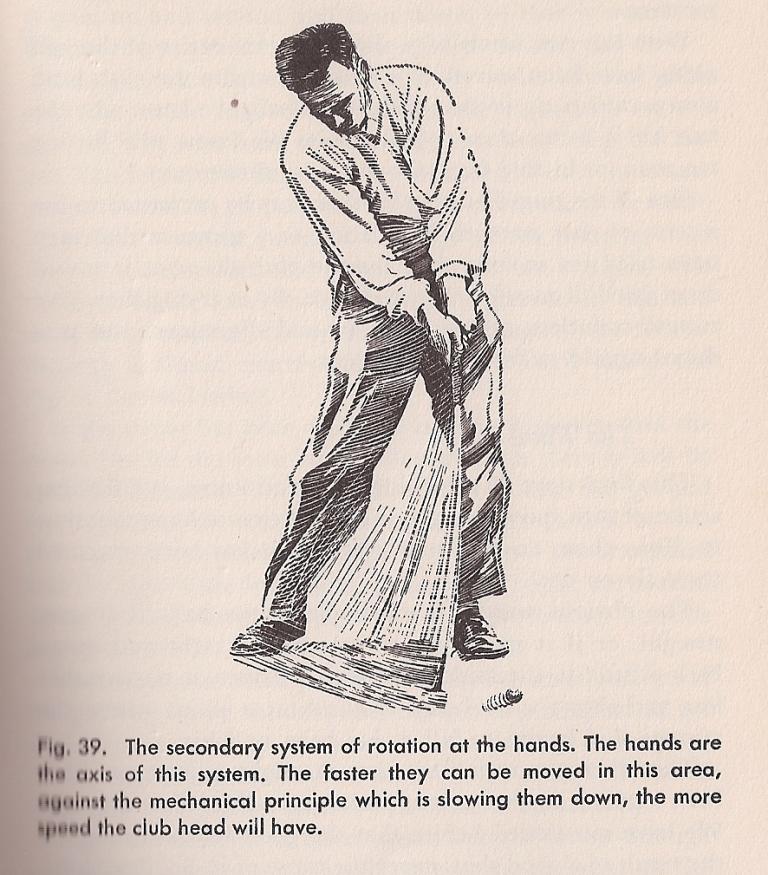There is a thread going that was started by Mandrin about COAM myth… I mentioned in it about a book I have that is close to 50 years old which had a COAM explanation in it.
I am going to reprint the chapter here for people to read…and when it is posted in full feel free to rebutt certain points etc
I read Mandrin’s analysis of the COAM myth and couldn’t make heads or tails of it… I read this Dante’s explanation and had a better understanding. So using Dante’s book as an example tell me/us why his thoughts were erroneous so we may get a better picture of it all. I kind of like the simplicity of what he says and can relate a LOT of it to what the ABS modules are having us do with training our swing
C.O.A.M-- Conservation Of Angular Momentum…by Joe Dante 1963 from the book The Four Magic Moves to Winning Golf
The golf swing, it should come as no surprise, is a practical application of the science of physics. Physics is the science of the phenomena of inanimate matter involving no chemical change. More simply, it is the study of the strange and seemingly unaccountable things which happen to matter that isn’t alive.
One branch of physics is mechanics. A subdivision of mechanics deals with angular momentum, or the rotation of things around an axis.
When an object rotates around a fixed axis it rotates at a constant rate of speed (until friction or gravity slows it down) so long as the object stays at the same distance from the axis. If the object is brought closer to the axis, it automatically speeds up; if it is moved farther out from the axis it slows down.
Example: a man sits on a rotating stool, holding a weight in each hand. Let him extend his arms to the sides as far as he can, holding the weights at arm’s length. Now let someone start him turning. While he is moving, let the man bring the weights in close to his chest. Immediately he will rotate on the stool much faster.
The reverse is also true. If the man starts rotating with the weights against his chest, he will slow himself down when he moves the weights out to arm’s length.
A more familiar example is the figure skater executing a pirouette. As he draws his arms in he speeds up in his rotation. The scientist explains this by saying that, if the distribution of mass with respect to the axis is changed, the rotational speed changes.
Remember that the mechanical principle is of the conservation of angular momentum. In other words, the momentum, once generated, remains in constant amount, regardless of how it is distributed. In the case of the man revolving on the stool the momentum is distributed back into the man as he brings the weights close to his chest.
The momentum will generally be distributed to the part of the system with the lesser mass, or to the part easiest to move. The stool, mounted on ball bearings, was the easiest thing to move in that classic example. But take the case of a man snapping a bullwhip. Here the momentum is distributed from the man’s arm and hand and the heavy butt of the whip, into the steadily tapering lash to the light tip. The tip has the least mass and is the easiest thing for it to move. The tip travels so fast- about 840 miles per hour- that it breaks the sound barrier and thus causes the whip to “crack”.
Now let’s see how COAM applies to the golf swing…
The player and the club may be viewed as a mechanical system. The mass we are interested in consists of the player’s shoulders, his arms and the club. The axis of rotation is a line along the spine, midway between the shoulders.
As the backswing reaches the top, the extensible part of the mass (arms and club) is quite close to the axis. The folded right arm is very close and so is the club, the latter only a few inches distant at that point. The left arm is as close at it ever gets.
Then, when the hips make their lateral movement to the left, turning and tilting the shoulders sharply, the original momentum is supplied that starts the downswing. The downswing of course, is the rotational action in which we are interested.
Immediately the arms start down, and as they do they begin to move away from the axis.
In the early states of the downswing the original speed momentum gives the arms and hands considerable speed. As the downswing proceeds, the arms, which are the chief mass, get farther and farther from the axis. The inexorable law of COAM begins to operate and the rotational speed of the arms slows down.
As they slow down- and this is the big point- the momentum generated in the beginning must go somewhere else. It does. It feeds into the club.
This increases the speed of the club in the last stages of the downswing, and the club head whips through its last quarter circle and catches up with the hands at the ball. The clubhead has to catch up with the hands as a matter of mechanical law.It cannot do anything else.
yes we know. You don’t believe it. You are jumping up with arguments and objections. Fine.
First, you say this theory would be logical if we were dealing with an ideal, self-contained mechanical system. But we are not. We are dealing with flesh and blood, with bones, muscles, tendons, joints and all the wonderfully complex human body. Cold mechanical principles just don’t apply.
They don’t?, The application of mechanical principles has enabled men to jump higher, with or without a pole, to throw a hammer and a discus farther, and put the shot farther. Why should the golf swing be the great exception?
The axis is present, through the spinal column between the shoulders and certainly the rotation is present. Why shouldn’t the laws that govern rotation apply, even though the golfer is not the ideal mechanical system? They apply to the man on the stool. It is true that certain of the golfer’s muscles do alter the action slightly, but not in the way you might expect. We will explain that later.
If you still think the strength of the hands must be used to bring the club head to the ball on time, try this experiment. Tee up a ball and swing at it with any club you choose. But instead of taking your regular grip, hold the club in only the thumb and second finger of each hand and as far towards the tips of these digits as possible. Don’t have any other fingers touching the club. You may not be able to take a full swing but you’ll get the club back quite far. You will find that without any effort on your part the club head will catch up with the hands at impact. The ball will go off the tee into the air and straight if the face is square. It won’t go very far, because with that grip you can’t swing hrd, but it will be a shot. You can do the same thing by swinging with only one hand, either the right or the left. Do you still think you need strong hands and wrists to whip the club head through?
Continuing your objections, you will argue that the arms and hands do not slow down as they approach the ball, that instead they go faster.
The answer is that you think they do. Multiflash photography proves that they slow down, in spite of your effort to speed them up. Study the multiflash photos. There is less space between the hands down near the point of impact than there is when the hands are in what is designated area A. This means the hands have not moved as far between flashes near the impact point as they had moved farther back. They are slowing down, despite the players effort to make them go faster. As they slowed (because they were getting farther from the axis) the momentum was being fed into the club and the club head, as the pictures show, was moving faster.
But you still demur. Why, you ask, should momentum feed from the arms into the heavy club? The club is also part of the mass and it, like the arms, is getting farther from the axis. The answer is that the club, although it feels heavy, is actually much the lighter part of the arm/club mass. The club will weigh thirteen to fourteen ounces. The arms of the average man will weight ten to twelve pounds apiece. The club then only represents five percent of the complete mass.
If you don’t think there is enough momentum being fed into the club to make it go fast near the bottom of the swing, you can do a pretty good job of proving how much there is. Take a club, swing it to the top, and bring it down hard, but try to keep the maximum wrist break you had at the top. Keep it all through the swing. Don’t let the angle you had at the top ever open up. Try it. You’ll find that it is almost impossible. If, with great muscular strength, you succeed in partly holding the angle, your shoulders will be turned so violently that you will be thrown off balance- off your feet, even if you swing hard enough.
The reason for this is that when you hold the angle closed, as it was at the top of the swing, you are not allowing much angular momentum to feed into the club, and since you are keeping it from the club, most of it goes into the shoulders. Now do you believe us when we say that a great deal of momentum feeds into the club when you just let it go.?
We think we hear you asking; If the slowing down of the arms causes momentum to flow into the club, why wouldn’t it be better to stop the hands, or try to, at the ball and let the club head whip through, much as you snap a whip?
The answer is that you can, if you want to, and you won’t get too bad a result. The late Abe Mitchell, a fine British professional, did something like that, and he was noted for his long driving. He didn’t look good, because he had a peculiar cramped, choked-off follow through. Golf writers of the period referred to his influence as the “bane of British golf”. What happened apparently, was that his imitators tied themselves in knots trying to choke off their follow through, without applying the whiplike lash that Mitchell unconsciously got. It was finally decided that only a man with hands as strong as Abe’s could ever duplicate his swing and the imitators gave up trying.
Actually a deliberate slowing down of the arms and hands should not be attempted, for two reasons. The first is that it isn’t necessary; enough momentum will feed into the club from the hands and in plenty of time, without trying to force it. The second reason is that the movement of the hands toward and past the ball adds to the speed of the club at impact. We’ll go into this just a little later.
…Remember the principle, that a change in the distribution of the mass about the axis causes a change in rotational speeds. Now, at the top of the backswing we found that the mass (the club and the arms) was close to the axis. As we start the downswing with the hip movement we should keep the angle of extreme wrist break that we had at the top. This means retaining the angle between the left arm and the club shaft. If we do that we keep the club from moving away from the axis quickly. But if we immediately open up that angle, we get some of the mass, even though it is a small amount, moving away from the axis rapidly at the very outset and the whole rotation is retarded.
By the time we are halfway down, this retarded rotation, which was never very fast to begin with, has almost permitted the club head to catch up with the hands. This results in the early hit…In reality it is the slow hit, because the hands never got moving fast enough to make it a fast hit.
Perhaps it will be clearer if you think of it in another way. Take a club and swing it back to the top without any wrist break whatsoever. It isn’t easy so do it slowly. Now try to swing it down fast, at your normal swinging speed. You’ll find you can’t do it at your normal speed. You can’t because you can’t get it started as fast. And you can’t get it started as fast because too much of the mass is too far away from the axis. It’s like starting to turn a small wheel and a large wheel of the same mass. It takes more effort to get the big wheel started because the big wheel has most of it’s mass farther out from the axis.
The correct swing retaining the wrist break, is like the small wheel. It’s easy to get started and the energy put into it produces a fast rotation. The poor swing, hitting too soon and opening the arm/shaft angle. is like the big wheel, hard to get started and never reaching much rotational speed.
Since the late hit is the fast rotation and the early hit is the slower one, the club head travels faster with the late hit and the ball goes farther.
How The Hands Help
This brings us to something else, the actual function of the hands. Up to now we have regarded them as nothing more than hinges or connecting links between the arms and the club. In a large sense that is true. We never should use the hands to forcibly straighten out the angle between the left arm and the club shaft. We have seen how conservation of momentum does this automatically. But the hands have their use, as does sheer muscular strength. as we shall see.
The original rotational system consists of arms and club swinging around a fixed axis midway between the golfer’s shoulders. Now, as the downswing gets under way, the angle between the left arm and the shaft of the club remains(or should remain) what it was at the top. But as the downswing proceeds this angle begins to open up slightly. When it does we set up a secondary system of rotation, that of the club alone rotating around an axis formed by the hands. When the hands get down to the hitting position the angle opens up very rapidly, until it reaches about 180 degrees (a straight line) at impact.
Within this secondary system there is no additional feeding of momentum due to the mass moving from it’s axis; the club is rigid and nothing in it moves in relation to the axis. But the axis itself moves. The axis of this system is at the hands, and so it moves along with them in the same direction as the club. They are slowing down, to be sure, because they are getting farther from our primary axis, through the spine, but they are nevertheless moving. Their speed adds somewhat to the speed of the club head. The faster we can make our hands move, down in the hitting area, the faster we will move the club head. This is the point at which sheer muscular strength counts.
At this point COAM is ‘fighting’ the muscular effort to make the hands go faster. Obviously the stronger the person wielding the club, the greater the force he can apply from outside the system itself- which is what he is doing- and the faster he can make the clubhead travel.
This is of course the point in which the human being swinging the club differs most from the ideal mechanical system on which the principle is based. There are no muscles in the mechanical system.
So, the hands do have their part, although the role is not what most of us have thought. Few of us have ever envisioned them as the moving axis of a secondary system of rotation.
With this knowledge the deeper mysteries of the golf swing have been solved. We now know why the club head always catches up to the hands at the ball. We know why the late hit is better than the early hit. We know why hitting too soon, or hitting from the top, is so disastrous.
One of the tragedies of golf, if we may be permitted to use a term of that strength in relation to a game, is that men have tried for so long to make a club do what it would actually do of itself, if merely given a chance. By so trying they have ruined countless swings, tempers and digestions and produced untold millions of bad shots…



